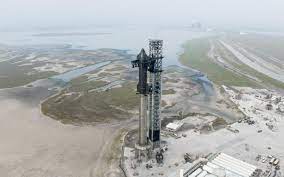Manas Dasgupta
NEW DELHI, Apr 20: Iconic giant new rocket Starship, owned by billionaire Elon Musk’s company SpaceX, the largest and most powerful ever built to send astronauts to the Moon, Mars and beyond, blasted off on its first test flight on Thursday but exploded minutes after rising from the launch pad and crashed into the Gulf of Mexico.
Musk, however, immediately said the next Starship test will be in a few months.
Elon Musk’s company was aiming to send the nearly 120-metre Starship rocket on a round-the-world trip from the southern tip of Texas, near the Mexican border. It carried no people or satellites.
The plan called for the booster to peel away from the spacecraft minutes after lift-off, but that didn’t happen. The rocket began to tumble and then exploded four minutes into the flight, plummeting into the gulf. After separating, the spacecraft was supposed to continue east and attempt to circle the world but crashed into the Pacific near Hawaii.
Minutes after SpaceX congratulated itself on an “exciting first integrated flight test of Starship”, the company tweeted that the rocket “experienced a rapid unscheduled disassembly before stage separation.”
At the three-minute mark commentators indicated an issue with the test flight. The rocket began to flip for the separation stage and the rotating rocket could be seen in the SpaceX livestream. Starship should have separated from the super-heavy booster but the rocket continues to rotate, the commentators said. “This does not appear to be a nominal situation,” the commentator stated after which the rocket exploded in the sky.
The gigantic rocket successfully blasted off at 8:33 am Central Time (1333 GMT) from Starbase, the private SpaceX spaceport in Boca Chica, Texas. The Starship capsule had been scheduled to separate from the first-stage rocket booster three minutes into the flight but separation failed to occur and the rocket blew up.
Despite the failure to complete the full flight test, SpaceX declared it a success. “We cleared the tower which was our only hope,” said Kate Tice, a SpaceX quality systems engineer.
“With a test like this, success comes from what we learn, and today’s test will help us improve Starship’s reliability as SpaceX seeks to make life multi-planetary,” SpaceX tweeted. “Congratulations to the entire SpaceX team on an exciting first integrated flight test of Starship!”
After a failed first attempt on Monday, where lift-off of the giant rocket was called off just minutes ahead of the scheduled launch time because of a pressurization issue in the booster stage, there was great excitement for this launch. Elon Musk had been hesitant about the launch. The SpaceX owner had warned ahead of the launch that technical issues were likely and sought to play down expectations for the inaugural test flight. “It’s a very risky flight,” he said. “It’s the first launch of a very complicated, gigantic rocket. There’s a million ways this rocket could fail,” Musk said.
Throngs of spectators watched from South Padre Island, several miles away from the Boca Chica Beach launch site, which was off-limits. As it lifted off, the crowd screamed: “Go, baby, go!” The company plans to use Starship to send people and cargo to the moon and, eventually, Mars.
NASA has reserved a Starship for its next moonwalking team, and rich tourists are already booking lunar flybys. It was the second launch attempt. Monday’s try was scrapped by a frozen booster valve. At 394 feet and nearly 17 million pounds of thrust, Starship easily surpasses NASA’s moon rockets — past, present, and future.
The stainless steel rocket is designed to be fully reusable with fast turnaround, dramatically lowering costs, similar to what SpaceX’s smaller Falcon rockets have done soaring from Cape Canaveral, Florida. Nothing was to be saved from the test flight. The futuristic spacecraft flew several miles into the air during testing a few years ago, landing successfully only once. But this was to be the inaugural launch of the first-stage booster with 33 methane-fuelled engines.
SpaceX foresees eventually putting a Starship into orbit, and then refueling it with another Starship so it can continue on a journey to Mars or beyond. The eventual objective is to establish bases on the Moon and Mars and put humans on the “path to being a multi-planet civilization,” according to Musk. “We are at this brief moment in civilization where it is possible to become a multi-planet species,” he said. “That’s our goal. I think we’ve got a chance.”
For the records, Starship is a fully reusable transportation system that is designed to carry both – humans and cargo to Earth orbit, the moon, and beyond. It is the world’s most powerful launch vehicle that is capable of carrying up to 150 metric tonnes of reusable fuel. Starship is capable of carrying crew and cargo to Earth orbit, the Moon, Mars, and beyond and is capable of point-to-point transport to Earth, enabling travel to anywhere in the world in one hour or less.
Starship is capable of carrying up to 100 people on long-duration, interplanetary flights, which will help in satellite delivery. The lower-stage Super Heavy booster and the upper-stage Starship vessel are designed to be used as reusable components to perform re-entry to Earth for soft landings.
If the test flight had been successful, the Super Heavy booster would have executed the beginnings of a controlled return flight before plunging into the Gulf of Mexico. Elon Musk’s Starship is designed to be two times more powerful than NASA’s own Space Launch System (SLS) which made its debut un-crewed flight to orbit in November last year.

